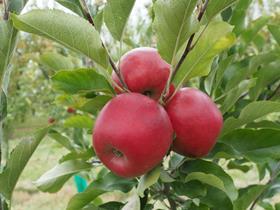
A New Zealand trial of two new apple varieties bred at Cornell University in the US has produced fruit for the first time. Marketed as SnapDragon (pictured) and RubyFrost, the two varieties – with the cultivar names NY1 and NY2 – were patented by Cornell in 2011.
In the US, the apples are exclusive to New York producer cooperative Crunch Time Apple Growers.
Following steady growth in the US domestic market, Cornell partnered with Washington-based Proprietary Variety Management (PVM) to begin trialling the fruit for commercial production, with the goal of turning them into globally recognised brands.
PVM licenced long-time associate The New Zealand Fruit Tree Company (NZFTC) to test and evaluate the selections in Southern Hemisphere conditions.
The trial in New Zealand began in 2018, with the first crop harvested in March this year. John Morton, chief executive of NZFTC, said the results have been impressive so far.
“The SnapDragon trees are very precocious, producing Gala-sized fruit. The fruit is attractive and highly coloured, sweet with an aromatic flavour that ripens early to mid-season. The maturity is similar to Dazzle and Jazz, which is appealing for those companies not involved with these varieties,” said Morton.
“Unfortunately, we’ve only had limited amounts of both SnapDragon and RubyFrost, but we’re immediately impressed with the quality.
“RubyFrost has shown strong productivity and appearance, ripening late season (similar to Fuji), the fruit is large and fully coloured. We’ve yet to sample this year’s harvest, as it’s best out of long-term storage, but off the tree it was crisp and juicy, with a full flavour,” he noted.
While these new varieties hold some similarities to existing varieties, Morton singles out SnapDragon as the most unique, noting it will be important to get the balance between fruit and yield correct, given its growth patterns.
“It’s a relatively weak growing tree, so we will seek overseas advice on how to get the balance right,” he said.
“As for RubyFrost, it appears to have traits similar to one of its parent-Braeburn. While we will seek overseas advice on this, we also feel comfortable applying local knowledge to this process.”
In an interview with Asiafruit in early March, chief executive of peak industry body NZAPI, Alan Pollard, said the country’s growers had been turning their attention to trademark-protected options from traditional varieties.
“We’re expecting our Braeburn export crop to be down 19 per cent compared to last year, and 30 per cent – or approximately 1m cartons – down on 2018,” said Pollard.
In terms of future prospects for the variety, Morton hopes SnapDragon and RubyFrost will provide an alternative option to growers looking to keep up with the trends of the industry.
“To remain competitive, you must hold a position in the marketplace. That means that you must have something that others want. Envy, Jazz, and Dazzle are good examples of achieving this,” said Morton.
“Everyone is looking towards improved orchard performance by planting better performing varieties, and hopefully SnapDragon and RubyFrost can do this.”
But he is quick to stress the industry and growers can’t put the cart before the horse.
“While marketing organisations may have marketing aspirations for a variety, it must work for the grower. Orchard development is expensive and any decision to commercialise a variety can’t be taken lightly,” he said.
Asiafruit is now available to read on your phone or tablet via our new app. Download it today via theApp StoreorGoogle Playand receive a two-week free trial along with access to previous editions.



